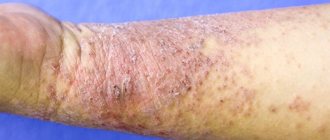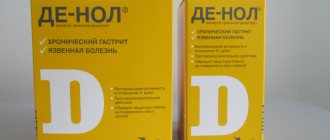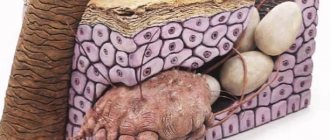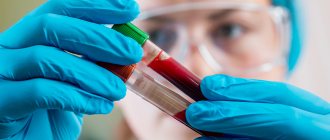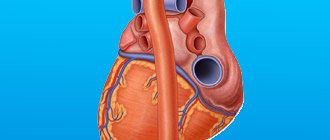Author
: Grachev Ilya Illarionovich
Editor
: Efremov Mikhail Mikhailovich
Date of publication: 05.13.2014 Date of update: 12.11.2020
Muscle pain, which can either intensify during movements or touches, or torment a person constantly, even at rest, is a reason to think about your health. Myalgia is the name of this common disease, and both older people and children suffer from it.
A large number of people around the world suffer from this disease, which negatively affects the quality of life, disrupting their usual routine. Myalgia is a disease that requires accuracy in diagnosis and correct, individual treatment. It has many manifestations and a variety of factors can trigger its development.
Myalgia does not go away on its own and has serious complications, so you should not delay treatment.
See how easily the disease can be cured in 10-12 sessions.
Causes of myalgia
It is very difficult to list all the causes of myalgia: the very lifestyle of a modern person is a negative factor that increases the chances of contracting this disease. The most common reasons include:
- Stress, prolonged emotional tension.
- Excessive physical activity overstrains the muscles, as a result of which myalgia develops, and a complete lack of exercise can also cause the disease.
- Infectious diseases such as influenza virus and ARVI. Spinal diseases, arthritis, radiculitis.
Complications
Untimely treatment of myalgia poses a risk of developing:
- osteochondrosis;
- arthritis, arthrosis;
- radiculitis;
- joint contracture;
- pathological mobility of the vertebrae in any area of the spinal column.
At the last stage of the disease, muscular dystrophy and serious nervous disorders develop. A person may become disabled.
Symptoms of myalgia
Basically, the symptoms of myalgia manifest themselves in the form of pain, and the pain can be of a different nature and concentrated in different areas. But not only the presence of pain indicates an illness. This disease is characterized by a number of other symptoms:
- Pain in muscles, joints, ligaments.
- Heaviness in the limbs.
- Hypertension, headaches.
- Dizziness, weakness, nausea and even vomiting.
What is POSSIBLE for diseases of the spine
What NOT to do for spinal diseases
Classification of muscle pain
Depending on the severity of the manifestation, there are:
- Acute intercostal myalgia. It occurs as a result of mechanical damage to muscles, during injuries and physical stress, as well as during the development of infectious diseases. The intensity of the discomfort varies over a wide range, and the pain completely disappears within 3-6 days.
- Chronic pain lasts several weeks, and its appearance and persistence indicates myofascial syndrome.
Types of myalgia are grouped by degree:
- 1st degree – local pain, which makes itself felt when exposed to a damaged or inflamed muscle. Seals are felt in the fibers, and involuntary twitching occurs when palpated.
- 2nd degree - the pain is spontaneous and nagging in nature, muscle strength decreases, the pathological process partially affects the subcutaneous layer.
- Grade 3 – severe pain during activity and rest, affecting a muscle group. Muscle strength decreases by 30% or more.
Treatment methods for myalgia
In our clinic, myalgia is treated using techniques that have stood the test of time for centuries. The wisdom of oriental healers and the achievements of modern medicine - this symbiosis allows you to comprehensively and effectively influence the existing problem, completely solving it. We offer the following treatment methods:
- Acupuncture. Using special needles, the impact on specific areas of the body allows you to quickly relieve muscle spasms and quickly relieve pain.
- Massage. Honey, acupressure or general massage allows you to quickly relax tense muscles and have a general relaxing effect on the entire body, due to which myalgia recedes. Pinched nerves are released, and metabolic processes improve.
- Hirudotherapy. The essence of the procedure is to stimulate bioactive points of the body through the bite of a medicinal leech. This method allows you to achieve an incredible reflex effect, since leeches not only mechanically affect the body, but also biologically.
- Stone therapy. The method is based on the healing power of heat; this heat not only relaxes overstrained muscles, but also has a positive effect on the blood circulation process, improving tissue nutrition and promoting their recovery.
- PRP therapy is the newest way to stimulate recovery processes. It is used to restore the functions of various organs after diseases and injuries, including to restore the function of the musculoskeletal system in case of myalgia.
We combine proven techniques of the East and innovative methods of Western medicine.
Read more about our unique method of treating Myalgia
Treatment of myalgia at the Paramita clinic
The main advantage of our clinic is accurate diagnosis. The examination is carried out to identify muscle tension. Attention is paid to the patient's symptoms and history. Thanks to a careful examination, effective treatment for myalgia is prescribed. After the first sessions, patients note that the pain gradually recedes and how much their overall health improves.
An individual approach, gentle but effective methods of influencing the problem and professionalism - these are the conditions due to which a quick and long-term result is achieved: myalgia recedes, and health problems cease to remind of themselves for a very long time!
Sign up for a free initial appointment
Our doctors
Belikov Alexander Valerievich
Neurologist, Candidate of Medical Sciences
21 years of experience
Make an appointment
Novikova Larisa Vaganovna
Neuropathologist, Candidate of Medical Sciences, doctor of the highest category
Experience 39 years
Make an appointment
Pankov Alexander Rostislavovich
Neurologist
40 years of experience
Make an appointment
Stages of the disease
- Sometimes the disease is preceded by a feeling of malaise and weakness.
- The pain may gradually increase or, conversely, suddenly manifest itself.
- A “myopathic syndrome” appears when climbing (from a sitting position, up stairs) and the pain intensifies.
- There is a feeling of stiffness and limited body mobility.
- There is a feeling of constant tension.
- If the cause of the disease is serious enough, the next stage may be pain in the joints and bones.
- Possible fever and chills.
List of sources
- Shostak N. A., Pravdyuk N. G., Novikov I. V., . Trofimov E. S. Myalgia in therapeutic practice – approaches to differential diagnosis, treatment // Attending physician. No. 3 p. 21-24.
- Ivanichev G.A. Pathogenetic aspects of the formation and manifestation of classical muscle pain syndromes. Manual therapy. 2009; 3 (35): 3–12.
- Busheneva S.N., Kadykov A.S., Piradov M.A. Myofascial syndrome: from theory to practice. Russian medical journal. 2005; 22. p. 57-62.
- Godzenko A.A., Badokin V.V. Local therapy of myofascial pain syndrome. RMJ. Rheumatology. 2007; 26: 1998–2003.
- Osipova N. A., Abuzarova G. R., Petrova V. V. Principles of using analgesics for acute and chronic pain. Clinical recommendations. M.: FSBI “MNIOI im. P. A. Herzen” Ministry of Health and Social Development of Russia, 2010. 67 p.
Diagnosis of myalgia
Many people do not attach importance to muscle pain, considering it a consequence of fatigue. But it should be understood that all processes in the human body are closely connected; damage to one of the systems can unpredictably affect the other. Therefore, it is better to use modern diagnostic methods:
- collecting the patient's medical history;
- Ultrasound of superficial muscles;
- MRI for muscle groups located deep in the body;
- taking samples for infections;
- Needle electroneuromyography is performed to assess muscle activity.
Etiology and pathogenesis
It is impossible to determine exactly why RPM occurs, but, according to statistics, the appearance of the disease is usually provoked by the following factors:
- viral infection;
- hypothermia;
- prolonged exposure to stressful situations;
- suffered acute respiratory diseases;
- hereditary factors.
So, previous viral infections can be considered predominantly risk factors, since examination of patients with polymyalgia rheumatica reveals the presence of elevated titers of antibodies to adenoviruses and respiratory syncytial viruses. Possible causes of the pathology may also be: infections caused by parainfluenza viruses and giant cell temporal arteritis (so-called Horton's disease).
Polymyalgia rheumatica
Polymyalgia rheumatica affects on average one in a thousand people. Most often women over 50 years of age are affected; men and young women get sick extremely rarely. The causes of polymyalgia rheumatica are not fully understood. According to my observations, approximately 70% of patients get sick due to severe stress. In addition, polymyalgia rheumatica often develops as a complication of other rheumatic diseases (for example, rheumatoid arthritis), and can also be a complication of certain cancer or infectious diseases, in particular severe influenza. Several patients I treated associated their polymyalgia rheumatica with severe hypothermia.
Symptoms of polymyalgia rheumatica
In most patients, polymyalgia rheumatica begins with severe pain and muscle stiffness in the hips and around the shoulder joints. Many doctors, having examined such a patient, mistakenly diagnose “arthrosis of the hip and shoulder joints” or “arthritis” or write off the patient’s complaints as “osteochondrosis of the spine with pain radiating to the upper and lower extremities.”
The paradox is that in fact, neither the spine nor the joints themselves are practically affected by this disease. Polymyalgia rheumatica is an inflammatory muscle disorder that, without proper treatment, leads to serious complications. Therefore, I would like to draw your attention to those points that will give us reason to assume that we are not dealing with an ordinary joint disease, but with polymyalgia rheumatica.
The first most important symptom of polymyalgia, which allows us to distinguish it from joint diseases, is incredible weakness . Due to weakness, most patients are simply brought to the doctor “under the arm.” It is characteristic that weakness is not expressed in the whole body, but in certain muscle groups - in the muscles of the shoulders (from the neck to the elbows), hips and gluteal muscles. It is difficult for patients to raise their arms up, comb their hair, wash their face, get up from a low chair or climb stairs, and it is difficult, I repeat, not because of pain, but because of extreme muscle weakness.
The second distinctive feature of polymyalgia rheumatica is the symmetry of pain . Both the shoulders and hips and buttocks hurt absolutely equally, both on the right and on the left, with equal strength and in the same areas: pain in the arms does not fall below the elbow joints, and pain in the legs does not fall below the knees.
Although such symmetrical pain also occurs in other diseases, for example, rheumatoid arthritis and rheumatism, in these diseases inflammation almost always affects the “lower” joints of the arms or legs: feet, hands, wrist joints. With polymyalgia, inflammation does not reach here. In addition, arthritis occurs with obvious swelling and swelling of the joints, often with redness. With polymyalgia rheumatica, the joints do not change. There is only some “swelling” of the muscles in the area of the shoulders and hips, and even then not always.
What else is characteristic of polymyalgia: the most severe pain is observed in the morning with the first movements of the patient. At night, only those muscles that bear the body's weight hurt. In this case, pain does not bother a person if he has taken a comfortable position and is in a state of complete rest.
In 70% of cases, weakness and pain with polymyalgia rheumatica are accompanied by decreased appetite, weight loss (sometimes significant) and increased body temperature.
Diagnosis of polymyalgia rheumatica
Diagnosing polymyalgia rheumatica should not be difficult for a competent doctor - this disease has such characteristic symptoms that it is difficult to confuse it with any other. To confirm the diagnosis, it is enough to do blood tests: clinical, biochemical and rheumatic tests.
With polymyalgia rheumatica, inflammation levels in blood tests are simply off the charts. In addition, biochemical analysis data always shows an increase in the level of those indicators that indicate damage to muscle structures. The combination of symptoms characteristic of polymyalgia with these biochemical indicators should help a competent doctor make a correct diagnosis in time and begin treatment on time. This is especially important, since polymyalgia rheumatica, if not “caught” as soon as possible, can lead to serious complications.
Complications of polymyalgia rheumatica
A very common and serious complication of polymyalgia rheumatica is inflammation of the temporal artery, the so-called temporal arteritis. Temporal arteritis usually manifests itself as severe unilateral headache (in the temporal region), especially severe at night. In half of patients with arteritis, vision is significantly impaired, and one eye may even go blind. If left untreated, temporal arteritis can also lead to damage to the arteries of the heart and thus provoke myocardial infarction.
Treatment of polymyalgia rheumatica
Today, the only reliable treatment for polymyalgia rheumatica, which has proven itself well and allows you to quickly return a person to work, is taking corticosteroid hormonal drugs. All other treatment methods either give questionable results or are still in the experimental stage.
Of course, none of the patients are happy about the prospect of taking hormonal drugs. However, here modern medicine cannot yet offer any other alternative. And delay, as already mentioned, is fraught with serious complications - sometimes irreversible. That is why, although I am an opponent of hormonal drugs in many other cases, in this situation I still insist on their use. In addition, the therapeutic effect of corticosteroid hormones is so pronounced that already 3 days after the start of taking them, all doubts in patients are dispelled. And soon after the clinical manifestations of the disease have subsided, after about a month, the dose of hormonal medications can begin to be gradually reduced, and after 5–6 months they are usually discontinued altogether.
A case from the practice of Dr. Evdokimenko.
Inna Sergeevna, a 55-year-old woman, came to the reception, accompanied by her daughter. The daughter, one might say, almost carried her mother into the office in her arms. Inna Sergeevna told me that she was tormented by weakness and symmetrical pain in the hips and shoulder joints. Moreover, as Inna Sergeevna said, it is weakness, and not pain, that most hinders her from living. A woman does not have the strength to get up from a low chair or from a sofa. She cannot raise her hands to her head to comb or style her hair.
During the conversation, it became clear that Inna Sergeevna developed pain and weakness after two consecutive serious emotional upheavals (loss of her job and divorce from her husband). A month after losing her job and subsequent separation from her husband, the woman began to experience pain in her hips and shoulders, and after another 2 weeks, severe weakness and apathy. In addition, the woman noticed that in a short time she had lost about 4 kg. However, the patient associated this weight loss solely with worries and lack of appetite.
When these symptoms reached their climax, the daughter persuaded Inna Sergeevna to see the doctors. In one of the clinics, the woman had an X-ray of her shoulder and hip joints, and also took blood tests. X-ray examination, however, did not reveal any changes in the joints. But blood tests revealed serious “inflammatory” deviations from the norm: the woman’s ESR (ROE) and C-reactive protein were several times elevated.
Despite this, for some reason Inna Sergeevna began to be treated for “arthrosis of the shoulder and hip joints.” Naturally, the woman did not feel better from such treatment. Moreover, a month later she began to develop a complication - temporal arteritis and began to have severe headaches.
Then the daughter, seeing that the treatment was not helping her mother, “rummaged” on the Internet and, having read my article there about polymyalgia rheumatica, she herself diagnosed Inna Sergeevna. After which I persuaded my mother to come to my appointment. During the examination, I noticed the characteristic symmetry of the pain and the obvious weakness of the woman. Blood tests confirmed the diagnosis of polymyalgia rheumatica, which the daughter herself had given to her mother. After all, the test data indicated a serious inflammatory reaction in the body.
I had to prescribe hormonal treatment to Inna Sergeevna. I prescribed the woman prednisolone in fairly high doses - the situation required it. And within a day Inna Sergeevna felt much better. The weakness decreased so much that the woman “got back on her feet.” And after 2 weeks, the weakness, pain in the shoulders and hips disappeared completely. A little later, the headaches stopped completely.
At first, the patient continued to take prednisolone in high doses. But over the next 5 months, we were able, by gradually reducing the dose of prednisolone, to completely abandon the drug. After observing Inna Sergeevna for another year, I was convinced that in her case everything turned out well. However, it is unknown how it would have ended if the woman had continued to be treated for “arthrosis” for another 2-3 months.
Article by Dr. Evdokimenko© for the book “Arthritis”, published in 2003. Edited in 2011 All rights reserved.
READ MORE:
- You can read the first chapters from the book “The Secret Formula of Health” here
- Chapters from other books by Dr. Evdokimenko
- Where to buy books by Dr. Evdokimenko
